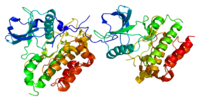
Photo from wikipedia
Abstract DNA binding proteins recognize DNA specifically or non-specifically using direct and indirect readout mechanisms like sliding, hopping, and diffusion. However, a common difficulty in explicitly elucidating any particular mechanism… Click to show full abstract
Abstract DNA binding proteins recognize DNA specifically or non-specifically using direct and indirect readout mechanisms like sliding, hopping, and diffusion. However, a common difficulty in explicitly elucidating any particular mechanism of site-specific DNA-protein recognition is the lack of knowledge regarding target sequences and inadequate account of non-specific interactions, in general. Here, we decipher the structural basis of target search performed by the key regulator of expression of c-myc proto-oncogene, the human RBMS1 protein. In this study, we have shown the structural reorganization of this multi-domain protein required for recognizing the specific c-myc promoter sequence. The results suggest that a synergy between structural re-organization and thermodynamics is necessary for the recognition of target sequences. The study presents another perspective of looking at the DNA-protein interactions.
Journal Title: Nucleic Acids Research
Year Published: 2021
Link to full text (if available)
Share on Social Media: Sign Up to like & get
recommendations!